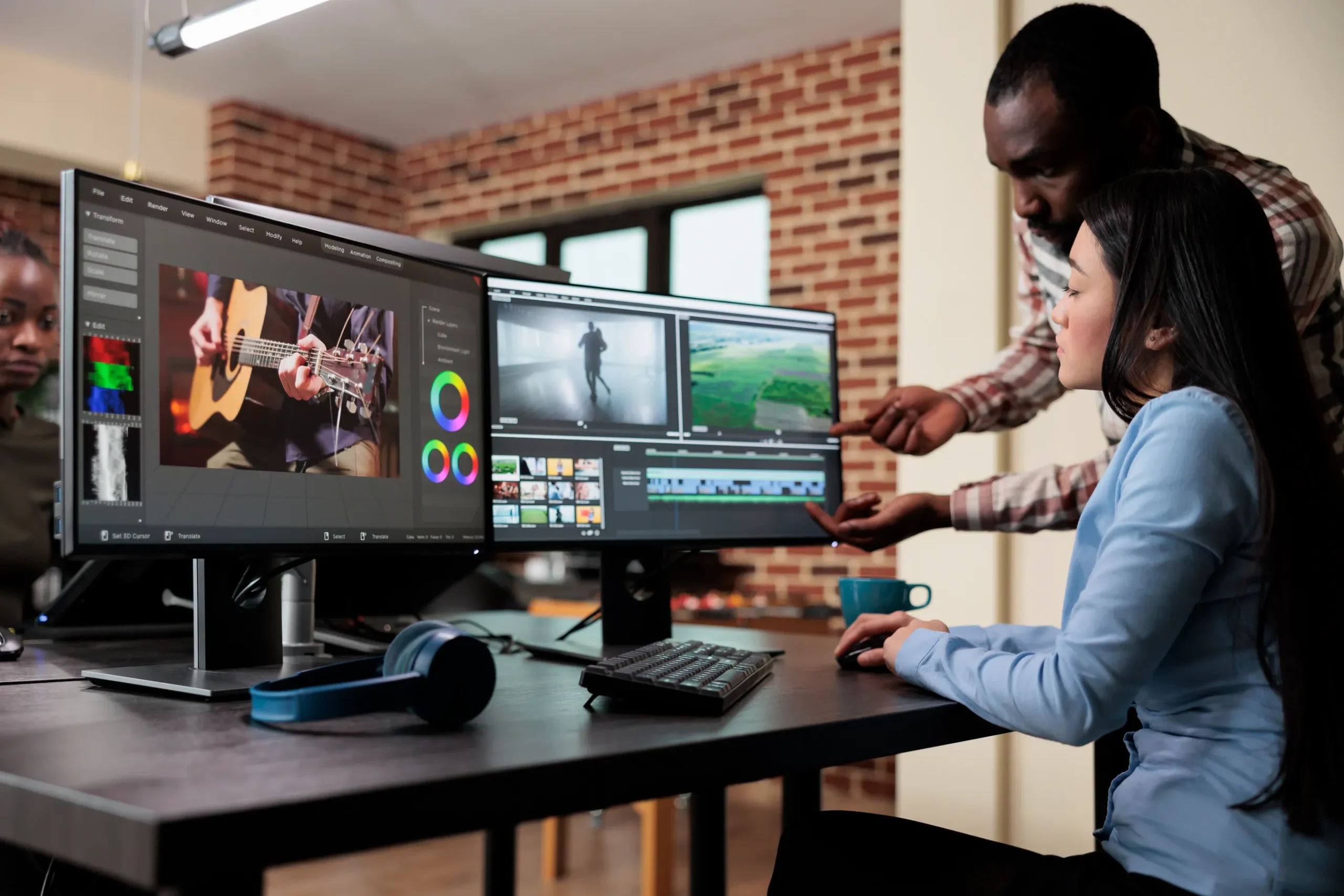
Welcome to the future of interior design, where technology and creativity converge to transform spaces into captivating realms of imagination. Imagine walking into a room and instantly being transported to a different world – one where walls come alive with interactive stories, furniture adapts to your needs, and every corner holds a surprise waiting to be uncovered. In this blog, we'll embark on a journey through the exciting realm of digital dynamics, where the boundaries between physical spaces and virtual experiences blur, leaving us spellbound.
Gone are the days of static interiors that merely serve a functional purpose. Today, technology breathes life into our surroundings, inviting us to explore, engage, and connect on a whole new level. From the mesmerizing dance of colors across the walls to the subtle integration of smart elements that respond to our touch, technology's role in interior design has evolved from novelty to necessity. We're no longer passive observers; we're active participants in the story that each space wants to tell.
As we delve deeper, we'll uncover the power of interactive interior visuals – the magic that happens when walls can speak, mirrors can reflect more than just our image, and furniture becomes a gateway to another dimension. We'll learn how technology is shaping interior design trends, propelling us into an era of minimalism enriched by hidden marvels, and biophilic designs that harmonize with intelligent climate control. Drawing inspiration from thought-provoking articles and visionary projects, we'll unravel how these trends are manifested in the real world.
But it's not all about the awe-inspiring aesthetics; it's about turning inspiration into action. In the chapters ahead, we'll guide you through the process of implementing interactive visuals, from collaborating with tech experts to seamlessly integrating digital wonders into physical spaces. And as technology leaps forward, we'll address the challenges it brings – privacy concerns, balancing innovation with the human touch, and ensuring that every interaction leaves a positive impact.
So, join us on this adventure, where we'll explore real-time applications that bridge the gap between imagination and reality. From transforming restaurants with dynamic AR artwork to revolutionizing how we experience real estate through VR tours, these case studies will show how the ideas we discuss aren't just theoretical concepts – they're pathways to innovation in action.
Are you ready to unlock the door to a world where technology and design intertwine, creating immersive experiences that captivate and inspire? Let's embark on this journey together and discover the endless possibilities of captivating customers through interactive interior visuals.
Hey there, interior design enthusiasts! Ready to dive into a world where your living room can turn into a tropical paradise in the blink of an eye? Let's talk about how technology and interior design have shaken hands to create some mind-blowing magic.
Remember the clunky VR headsets that used to make us look like futuristic explorers? Well, they've had a makeover – they're lighter, cooler, and ready to whisk you away. With virtual reality (VR), you can actually stroll through your new home, even if it's still on the drawing board. And AR? Oh, that's the tech that lets you preview how that chic sofa you've been eyeing will jazz up your den. Just point your phone and bam! Your room gets a digital makeover.
Hold on, because the real fun is the mix of reality and digital wizardry. It's called mixed reality (MR), and it's like having your imagination materialize in your space. Imagine designing your kitchen while digital creations pop up on your actual countertops – talk about a sneak peek into the future!
But wait, there's more. Tech isn't just about gadgets; it's about making your space come alive. Imagine your walls changing color with your mood or furniture that seems to know just how you like to lounge. From mood-adapting spaces to touch-responsive materials, the fusion of tech and design isn't just decorating – it's storytelling with a digital twist.
So, if you thought interior design was all about cushion patterns and paint swatches, you're in for a wild ride. Tech has turned interior design into a playground of imagination, and you're invited. It's time to paint your world with pixels and let your creativity run absolutely wild!

Picture yourself strolling into a room that comes to life the moment you step in. The lights sway to match your mood, and these amazing virtual images start playing across the walls. This is what interactive interior visuals can do, and trust me, it's like adding a touch of pure magic to the way we feel about spaces.
Sure, regular interior design is all about making things look good, but interactive visuals bring a whole new level of cool. They're not just still pictures – they're like living, breathing artworks. They grab your attention, make you feel all kinds of things, and turn spaces into something more like stories.
Imagine having a home where your wall isn't just a wall anymore. It's like a big canvas that reacts to you. Wave your hand, and suddenly your living room turns into this peaceful forest or a bustling city. And it's not just about the visuals – it's about you having the power to make it happen. You're in control, you're exploring, and that's something we all crave.
Studies even say that interactive stuff helps you remember things better and makes you feel all sorts of emotions. It's like reading about a place versus actually being there. When you get to be part of shaping an indoor space, it becomes a part of who you are.
Oh, and guess what? Brands are catching onto this too. Imagine walking into a shop and seeing things come to life right in front of you. Want to see if that new sofa fits your place? Boom, you can do it right there. It's like test-driving furniture for your own home.
The best thing about these interactive visuals? They mix the digital world with the real one so smoothly. They make it easy to jump from imagining something to actually feeling like you're there, trying it out. As technology keeps going, interactive interior visuals are totally going to change how we create, experience, and connect with spaces. It's like a sneak peek into the future, and it's looking amazing.
In today's rapidly evolving world, the blend of interior design and technology has birthed a captivating revolution that's reshaping the way we experience spaces. It's not just about picking colors and furniture anymore; it's about creating immersive journeys that transport us to new realms within our own four walls. Let's dive into some of the hottest interior design trends that are getting a digital upgrade:
1. Minimalism with a High-Tech Twist
Say hello to the era of smart furniture and concealed technology. Imagine sleek sofas that subtly charge your devices and minimalist coffee tables that double up as wireless charging stations. This tech-savvy minimalism not only saves space but also keeps your gadgets juiced up without compromising on style.
2. Biophilia Enhanced by Smart Living
Bringing nature indoors is an age-old design concept, but now it's getting a digital boost. Imagine a living wall that's not just aesthetically pleasing but also comes with an integrated smart system that monitors humidity and watering schedules. Pair that with adaptive lighting that mimics natural daylight, and you've got a harmonious blend of biophilic design and cutting-edge tech.
3. Augmented Reality Elevating Patterns and Textures
Ever struggled to decide if that funky-patterned couch matches your eclectic decor? Augmented reality (AR) is here to the rescue. With AR apps, you can visualize how different patterns, colors, and textures will look in your space before making a commitment. It's like trying on clothes but for your room!
These trends aren't just passing fads; they're a sneak peek into the future of interior design. By embracing technology's interactive possibilities, designers are unlocking new dimensions of creativity and functionality.
Whether you're a tech enthusiast or simply someone looking to spruce up your living space, these trends show that the marriage of technology and interior design is a match made in aesthetic heaven. So, get ready to step into a world where your imagination is the only limit, and your living space becomes a canvas for innovation.

Bringing your interior design dreams to life with interactive visuals is an exciting journey that blends imagination with innovation. Let's dive into how you can turn inspiration into a captivating reality:
1. Team Up for Tech Magic: Collaboration is key! Partner with tech-savvy experts who share your passion for creating immersive spaces. Their insights can transform your design concepts into interactive wonders that enchant your customers.
2. Choosing Your Tech Canvas: Selecting the right platforms for your interactive experiences is crucial. Augmented reality (AR) can overlay digital elements onto real-world settings, while virtual reality (VR) creates entirely new immersive environments. Your choice depends on the impact you wish to make.
3. Harmonizing Reality and Virtuality: Seamlessly integrating interactive elements within physical spaces requires finesse. Imagine a furniture showroom where customers use AR to see how a sofa fits in their living room. Balancing the virtual and the tangible ensures a harmonious experience.
4. Sparking the WOW Factor: Imagine walking into a café where your coffee cup triggers virtual art to bloom on the walls. Or stepping into a shop where touching a fabric sample brings up its intricate manufacturing process. These small, magical interactions spark the WOW factor and linger in customers' memories.
5. Trial, Error, and Perfection: It's okay to experiment and refine your interactive ideas. Test different approaches, gather feedback, and iterate. This process of trial, error, and perfection ensures that your interactive elements align seamlessly with your design vision.
By weaving technology into your interior design journey, you're not just creating spaces – you're crafting experiences that resonate with your customers on a deeper level. The intersection of creativity and technology opens doors to boundless possibilities, inviting your customers to become part of your narrative.
As we step into the exciting realm of interactive interior visuals, it's important to address a few challenges that might come our way. While technology can enhance our spaces, it's crucial to maintain a balance between its allure and the human touch that makes a space truly special.
1. Privacy Matters: With sensors and cameras powering interactive experiences, concerns about privacy can't be ignored. However, the solution lies in transparent communication. Businesses should make it clear what data is being collected and how it's being used. Providing opt-in options and anonymizing data can go a long way in ensuring customers' peace of mind.
2. Seamless Experience: The magic of interactive interior visuals lies in their ability to seamlessly blend with physical spaces. Poorly integrated technology can disrupt the flow of a room and distract from the overall experience. Collaborating closely with tech experts and interior designers can ensure that the technology feels like an organic extension of the design, rather than an afterthought.
3. Human Connection: While technology adds a futuristic flair, the warmth of human connection should never be compromised. Striking the right balance between technology and personal interaction is crucial. Use interactive elements to enhance, not replace, human touchpoints. For example, a virtual concierge might be convenient, but a friendly face at the front desk is irreplaceable.
In this dynamic landscape, where screens and sensors are becoming integral to our spaces, embracing these challenges head-on can lead to a harmonious blend of innovation and comfort. By addressing privacy concerns, ensuring seamless integration, and valuing human connections, we can create environments that captivate both the eye and the heart.
So, as you embark on your journey of infusing technology into interior design, remember that the best results come when we let technology empower our creativity, not overshadow it.
Read Also: Next-Generation Retail: How Immersive Experiences Impact Customer Loyalty and Retention
As we journey through the ever-evolving landscape of interior design, one thing becomes crystal clear: Technology is the brushstroke of innovation, and interactive visuals are the colors that bring spaces to life. The harmonious blend of these elements has ushered in a new era where our surroundings are no longer static backdrops, but canvases that respond to our very presence.
Imagine walking into a cafe where the walls transform with each passing moment, telling stories through dynamic art pieces that dance in sync with your emotions. Envision a living room where the furniture not only whispers tales of elegance but also invites you to explore its hidden technological marvels. This is the realm of possibilities that interactive interior visuals offer.
Through the lens of AR and VR, we're no longer confined by the limits of space. We can visualize and customize, turning mere ideas into tangible realities. The minimalist lines of modern design can blend seamlessly with the intricate world of haptic feedback, and biophilic havens can be enhanced with climate-controlling algorithms that mimic the soothing touch of nature.
As we tread this exciting path, it's vital to remember the human heart at the core of every creation. Technology enhances, but it's the designers' ingenuity that breathes life into spaces. As you embark on your own projects, fueled by the ideas in this blog, let your creativity be the compass guiding you through the sea of innovation.
So, whether you're an interior design enthusiast, a business owner, or simply someone who appreciates the beauty of art and technology intertwined, take the leap. Let the allure of interactive interior visuals shape your world. Embrace the future that unfolds as we weave together the threads of technology and design, crafting spaces that not only captivate but also connect on a deeper level.
FAQs
Absolutely, businesses can use AR/VR to create memorable experiences, attract customers, and showcase products/services innovatively.
Enhance customer engagement by integrating AR/VR for personalized and immersive interactions.
Dynamic elements that engage and transform spaces, merging technology and design.